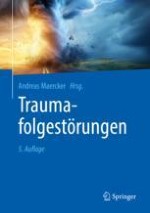Zusammenfassung
Eine fundierte und klug gewählte Diagnostik ist Grundlage jeder passgenauen Behandlung. Für den wissenschaftlichen Austausch ist sie unabdingbar. Diagnosebezogene Studien unterstützen versorgungs- und sozialpolitischen Entscheidungen. Für die posttraumatische Belastungsstörung (PTBS) stehen eine Vielzahl gut evaluierter Screening-, Selbstauskunfts- und Interviewinstrumente zur Verfügung, die zum Teil bereits an die Neuauflagen der Klassifikationssysteme angepasst wurden. DSM-5 (American Psychiatric Association) weitete die Kriterienkategorie und führte zusätzlich einen dissoziativen Subtyp der PTBS ein. ICD-11 (World Health Organization) setzte auf eine stringentere Fassung der PTBS und grenzte stattdessen das Syndrom der komplexen PTBS ab. Dieses Kapitel befasst sich daher einerseits mit etablierten Methoden, die ihre Gültigkeit behaupten konnten, sowie mit Neuerungen, die auf die modernen Klassifikationssysteme abgestimmt wurden.
